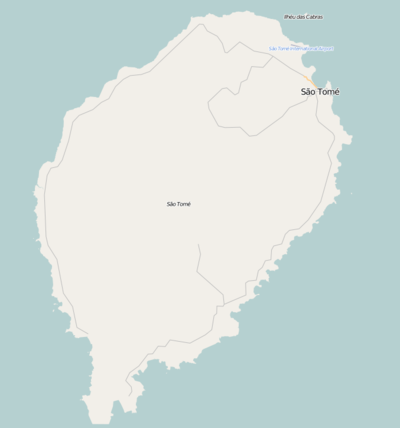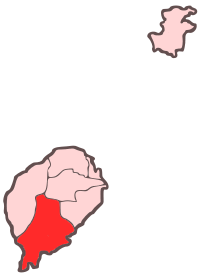Praia Inhame
| Praia Inhame | |
|---|---|
.jpg) Praia Inhame | |
 Praia Inhame Praia Inhame | |
| Location | Southern island of São Tomé, São Tomé and Príncipe near Porto Alegre |
| Coordinates | 0°01′29″N 6°31′11″E / 0.0248°N 6.5197°E |
| Access | dirt roads |
| Beach length | 2 km |
Praia Inhame, is a beach on the southernmost area and the southern coast of the island of São Tomé in São Tomé and Príncipe.[1] The beach is almost southwest of Porto Alegre and the National Route 2. The beach is located about 3 km north of the Equator.
Description
The beach sits in the southern headland of the island. It is crescent shape and is about a kilometer long and 10–20 meters wide, and are surrounded by forest as almost all the beaches in the island. Plantations are not domiant around the beach area except for the middle portion. Nearby beaches include Praia Cabana next to the small point in the east and Praia Piscina further west. A mound lies to the north. South of the beach is the island's southernmost point known as Ponta do Homem do Cabo? meaning the "man of the cape"?.
A hotel and villa complex exists, constructed somewhere around the turn of the century, it is called Eco Lodge (full name: Praia Inhame Eco Lodge). It is linked with a dirt road linking a track with a part of the west of the island as it does not connect to that of Neves and Porto Alegre and the national route. South is Canal das Rolas which separates Ilhéu das Rolas to the south.
History
The area including the southernmost point were mentioned in the 1616 map by Jodocus Hondius and the area was thought to be in the northern hemisphere[2] Later maps mentioned that was the equator was thought to be close to the north, in the 1665 map by Johannes Vingboons.[3] and the 1780 map by A. Dalrymple.[4] From the 19th century, it would be fully mapped as in the Northern Hemisphere with the equator slightly south in the channel as mentioned in a 1902 map in a modern spelling form, the equator was correct marked in 1922 at Ilhéu das Rolas..
Nature
It is abundant in flora and fauna, land and marine fauna are dominant, in the waters are fishes, sponges, mollusks including sea snails and others, notably crabs. Land fauna include, birds, frogs, lizards and insects.
A new species of snake was found in the area of the beach, in 2017. It was named Naja peroescobari, named after the 15th century Portuguese explorer Pero Escobar, one of three who discovered the island in 1471.[5]
See also
References
- ↑ Praia Inhame, Wikimapia
- ↑ 1616 map of the island of Saint Thomas (now São Tomé) by Jodocus Hondius, now at the French National Library
- ↑ 1665 map of the island of Saint Thomas (now São Tomé) by Johannes Vingboons, now at the Dutch National Archive
- ↑ 1780 map of the island of Saint Thomas (now São Thomé) by T. Harmar and A. Dalrymple, now at the French National Library
- ↑ Ceríaco, L.M.P.; Marques, M.P.; Schmitz, A.; Bauer, A.M. (2017). "The "Cobra-preta" of São Tomé Island, Gulf of Guinea, is A New Species of Naja Laurenti, 1768 (Squamata: Elapidae)". 4324 (1). Zootaxa. pp. 121–141. doi:10.11646/zootaxa.4324.1.7.
